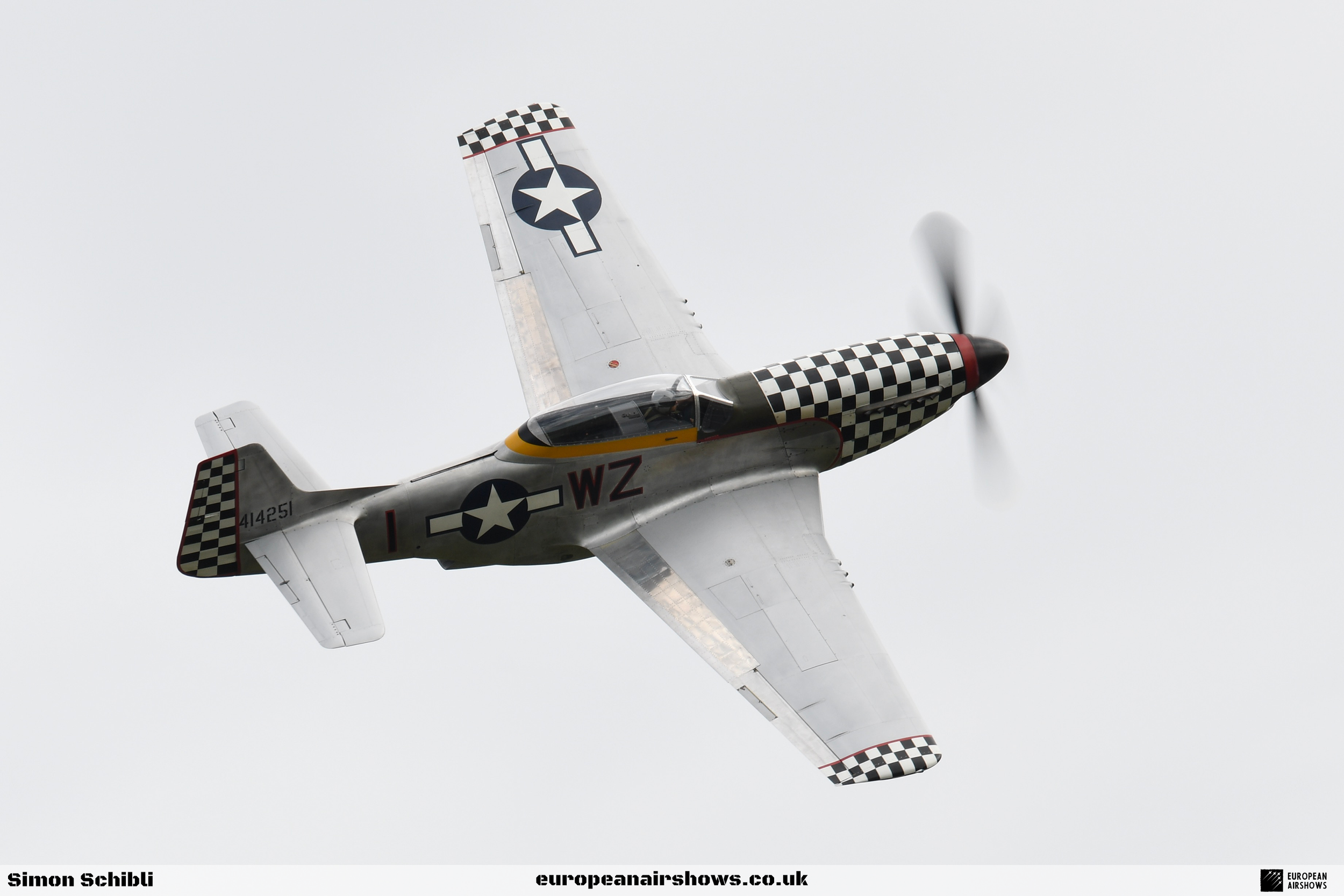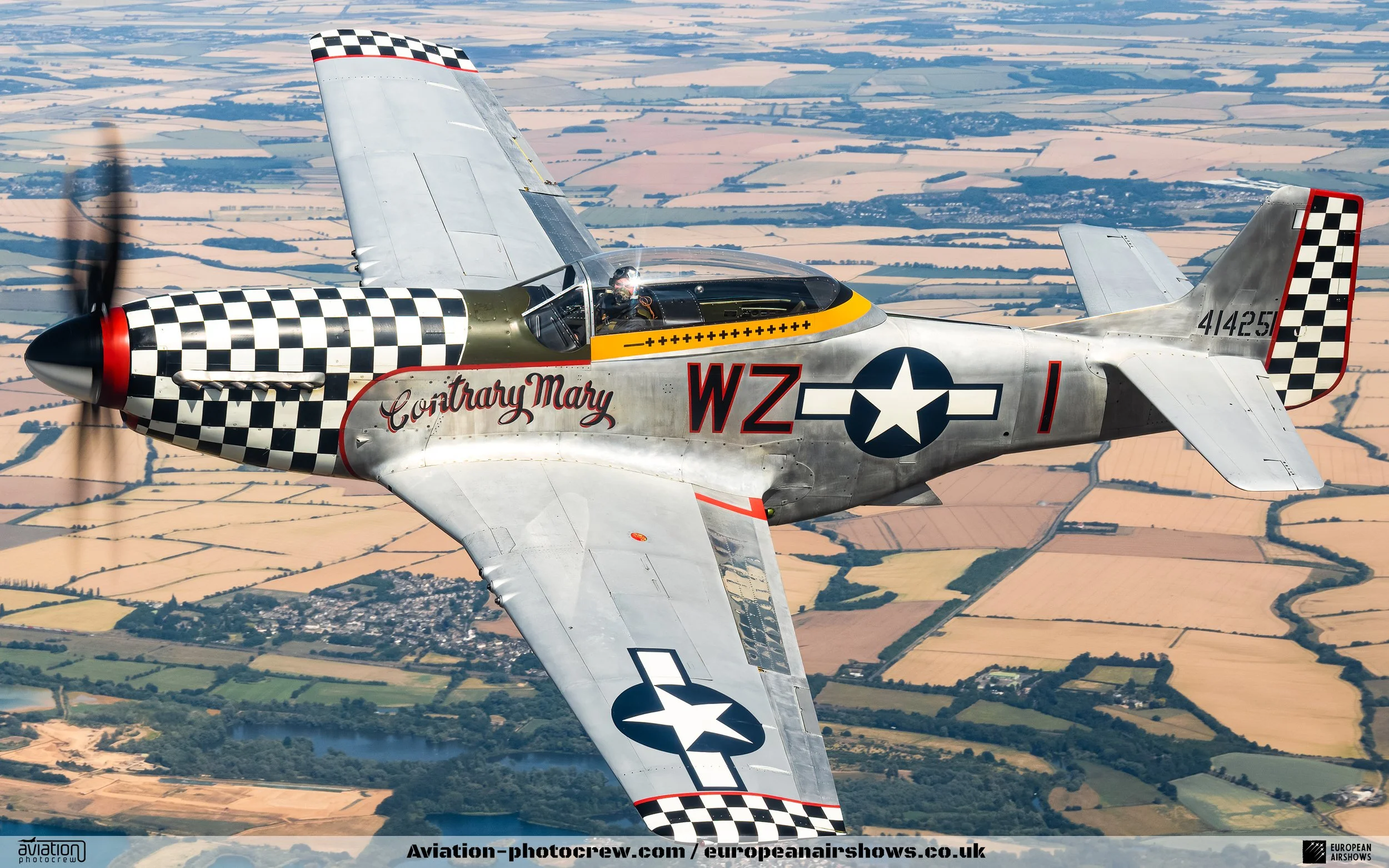
P-51 Mustang G-TFSI
About the Aircraft
The North American Aviation P-51 Mustang is renowned as one of the most effective and iconic American fighter aircraft of the mid-20th century. Designed in 1940 by a team led by James H. Kindelberger at North American Aviation (NAA), the Mustang emerged in response to a British request for a modern fighter to supplement the limited availability of the Curtiss P-40s. Instead of producing the older P-40 design under license, NAA proposed developing a more advanced aircraft, resulting in the creation of the NA-73X prototype. Remarkably, this prototype was completed just 102 days after the contract was signed and made its first flight on October 26, 1940. Initially powered by the Allison V-1710 engine, the early Mustang variants, known as Mustang Mk I, served effectively with the Royal Air Force (RAF) as long-range escorts and tactical reconnaissance aircraft, though their high-altitude performance was limited.
A significant advancement in the Mustang’s development came with the integration of the Rolls-Royce Merlin engine, which was first tested in mid-1942 under the designation Mustang X. This upgrade, featuring a two-stage intercooled supercharger, dramatically enhanced the aircraft’s performance at altitudes above 15,000 feet, making it competitive with top-tier Luftwaffe fighters. The introduction of the Merlin-powered P-51B/C models marked the Mustang’s transformation into a long-range escort fighter, crucial for the success of the USAAF’s Eighth and Ninth Air Forces in securing air superiority over Europe. The definitive P-51D variant, equipped with the Packard V-1650-7 Merlin engine and armed with six .50 caliber machine guns, became a staple in various theaters, including North Africa, the Mediterranean, Italy, and the Pacific, with Mustang pilots collectively claiming the destruction of nearly 5,000 enemy aircraft during World War II.
Post-World War II, the Mustang continued to serve prominently in the Korean War, now designated as the F-51, where it remained the primary United States fighter until the advent of jet-powered aircraft like the F-86 Sabre took over its role. Despite the transition to jets, the Mustang’s versatility allowed it to evolve into a specialized fighter-bomber, maintaining service with several air forces well into the early 1980s. Beyond its military legacy, the P-51 Mustang found a lasting place in civilian aviation as a beloved warbird and a competitor in air racing, symbolizing both engineering excellence and the enduring spirit of its pilots.
Specifications
Crew
1
Length
32 ft 3 in (9.83 m)
Wingspan
37 ft 0 in (11.28 m)
Height
13 ft 4.5 in (4.077 m)
Max Speed
440 mph (710 km/h, 383 kn)
Range
1,650 mi (2,660 km, 1,434 nmi)
Service Ceiling
41,900 ft (12,800 m)
Rate of climb
3,200 ft/min (16 m/s)
TF-51D Mustang
The TF-51D variant of the North American Aviation P-51 Mustang represents a specialized adaptation of the iconic fighter aircraft, tailored specifically for advanced pilot training. Developed during the transition period following World War II and the Korean War, the TF-51D was distinguished by its full dual cockpit configuration and bubble canopy, features that enhanced visibility and facilitated more effective instruction for trainee fighter pilots. This modification allowed instructors and students to operate the aircraft together, providing hands-on training in a visually optimal environment. The transformation from the single-seat P-51D to the two-seat TF-51D involved significant alterations to the fuselage and instrumentation to accommodate the additional crew member, ensuring that the aircraft retained its superior aerodynamic performance while serving its new training role.
Throughout its operational history, the TF-51D played a crucial role in preparing fighter pilots for the complexities of aerial combat and advanced maneuvering techniques. Utilizing the robust performance characteristics of the P-51D, including its Packard V-1650-7 Merlin engine and six .50 caliber AN/M2 Browning machine guns, the TF-51D provided a realistic training platform that mirrored the dynamics of frontline combat aircraft. These two-seat trainers were extensively used by the United States Air Force (USAF) to bridge the gap between initial flight training and the transition to jet-powered fighters. The TF-51D’s dual cockpit arrangement not only facilitated comprehensive training sessions but also allowed for real-time feedback and instruction, significantly enhancing the effectiveness of pilot training programs during its period of service.
The TF-51D remained a vital component of pilot training operations until the introduction and full deployment of jet trainers such as the T-33 Shooting Star. As jet technology advanced and became the standard for frontline fighter aircraft, the need for piston-engine trainers like the TF-51D diminished. However, the legacy of the TF-51D endures in its contributions to pilot proficiency and the seamless transition to more advanced jet platforms. Even after its primary role concluded, many TF-51D Mustangs found continued use in civilian aviation circles as warbirds and in air racing, celebrated for their historical significance and exceptional performance. The TF-51D variant thus stands as a testament to the versatility and enduring impact of the P-51 Mustang design in both military training and aviation heritage.
Did You Know?
- North American Aviation developed the P-51 Mustang in 1940 to provide the Royal Air Force with a more advanced fighter than the existing Curtiss P-40.
- Switching from the Allison V-1710 engine to the Rolls-Royce Merlin engine in mid-1942 significantly enhanced the Mustang’s performance at altitudes above 15,000 feet.
- The definitive P-51D model featured six .50 caliber AN/M2 Browning machine guns, making it a powerful fighter and fighter-bomber during World War II.
- Over 15,500 P-51 Mustangs were produced, primarily at North American Aviation’s facilities in Inglewood, California, and Dallas, Texas, with additional assembly in Australia.
- After serving prominently in World War II and the Korean War, the Mustang continued to be used by various air forces around the world until the early 1980s and became a popular civilian warbird and air racing aircraft.
Test Your Knowledge
TF-51D Mustang G-TFSI
The TF-51D Mustang G-TFSI, with the serial number 44-84847, is a historic fighter aircraft that was manufactured at North America’s Dallas Plant in 1944. As one of the last Mustangs produced during World War II, it played a significant role in the post-war era. In 1951, the aircraft was assigned to the 45th Tactical Reconnaissance Squadron, where it served in Kimpo, South Korea. Following its service in Korea, G-TFSI was returned to the United States and subsequently utilized by the Air National Guard.
In 1999, G-TFSI underwent a comprehensive restoration in North Dakota, returning the aircraft to its original specifications and aesthetic appeal. The following year, it was transported to the United Kingdom to join The Fighter Collection, a renowned organization dedicated to the preservation and display of historic military aircraft. Upon its arrival, the Mustang was painted to replicate the color scheme of Captain Frank Birciel’s aircraft, “Miss Velma,” from the 55th Fighter Group. Later, it was transferred to Anglia Aircraft Restorations Ltd, where it was repainted in the livery of the RAF Duxford-based aircraft “Contrary Mary.”
The dual-control TF-51D Mustang “Contrary Mary” became a prominent feature at airshows across the United Kingdom and Europe, captivating audiences with its impressive flying capabilities. It performed both solo displays and participated in the Ultimate Fighters display team, showcasing its agility alongside other iconic World War II aircraft until late 2023. The aircraft was meticulously maintained, serving as a testament to the craftsmanship of its original builders and the dedication of those who restored it.
In December 2023, “Contrary Mary” was dismantled and shipped to a new owner in the United States. Although the aircraft has departed from the UK, its legacy endures, marking its significance in aviation history as a symbol of the P-51 Mustang’s storied heritage and its contributions to military aviation.
Inactive Status
In December 2023 “Contrary Mary” was sold and shipped to a new owner in the United States












